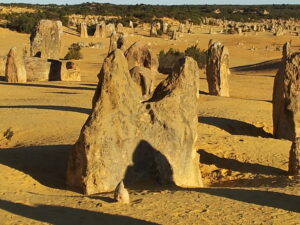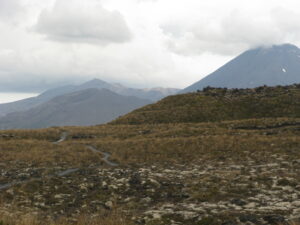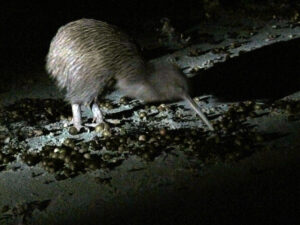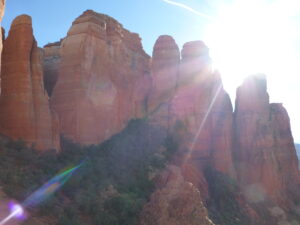About four hours drive from Hobart, the very civilized capital of Tasmania on the east coast, or a couple of hours from bustling Launceston at the midpoint of the north coast, you can delve into vast stretches of wilderness.

Tassie’s western half is largely wild. In the northern part, ranching takes up some room; in the south, the quiet and beauty can be broken occasionally by logging. In the middle at Strahan, you’ll find a bit of fish-farming and gawkers aboard touring boats.
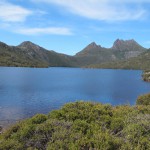
The rest is wilderness: Cradle Mountain-Lake St. Clair to the north, the larger Franklin-Gordon Wild Rivers National Park south of that, and the more inaccessible Southwest National Park in, yes, the southwest portion of the island. Together they comprise the Tasmanian Wilderness World Heritage Area. You can spend months here tramping in the bush or paddling the untamed rivers.
We found, however, that most visitors don’t venture west just because it is easy to reach, but because the wilderness can challenge them in different ways or reach some deeper part unsatisfied by the domesticated everyday world.
So it was with us in the linked reserves of Cradle Mountain and Lake St. Clair. Many visitors choose to cover the two parks by way of the renowned 65 kilometer Overland Track, a four to six day hike, camping outdoors or nesting in the well-outfitted Parks and Wildlife huts. We chose to do day hikes on the two end sections of the trail, each a vigorous outing, while we spent the nights in cabins at both areas. Though these end sections are popular and can be busy, we were still mostly alone on the trail. Here’s what we found.

The first portion of the Overland Track at Cradle Mountain snakes through meadows of button grass, then rises gently in woodlands past a picturesque waterfall and several smaller lakes cupped by the exposed mountains.

We emerged from the trees to pause at the pass looming over much photographed Dove Lake. Then we climbed more steeply, over loose rock and up a vertical cleft aided by anchored chains, to the grandest vista at Marion’s Lookout.

There, we found ourselves at the fulcrum between the mitten-shaped Dove Lake below and the peaks of Cradle Mountain. The encircling hills and the valleys beyond ebbed into the distant haze to the east. The distinctive U-shaped mountain shifted colors and surface detail as clouds danced about the sun. “You can even see the baby inside the cradle,” said the parks guide at the edge of Dove Lake. Perhaps you could if you squinted just right, but our minds were distracted by the exhilarating vista…and the pesky flies.

We had enough experience of the relentlessly buzzing, dive-bombing horse flies, on the trail as well as by mountain lakes and beaches of the eastern coast. Here they were a particularly annoying distraction from the visual splendor before us and the whispering breezes. As we picnicked, they seemed especially frenetic, though seemingly uninterested in the actual food.
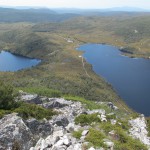
We endured, honoring the beauty around us as long as we could, shifting about to catch the gusts that whisked the flies away for a time. Eventually, we yielded, heading back down to the park’s access road to catch the shuttle to our cabin, one of a cluster amid the myrtle and gum forest, where wildlife foraged before us.
At the other end of the Overland Track, at Lake St. Clair National Park, vistas were less accessible. Its huge lake sits at a lower altitude, so most trails trace the thickly wooded edge of the lake or head through forest to smaller lakes.

We followed a bit of the lake shore, along beach and forested trail, on to an inlet called Platypus Bay. The park service had prepared dozens of viewing stations amid the trees for seeing the platypus in the wild, but they remained elusive to us. Many locals from Hobart – families as well as groups of friends – fill a weekend up here, hiking a few hours to the smaller lakes and camping in the wild.
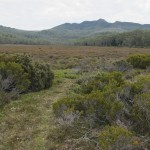
We hiked a four hour section of the Overland Track through typical Tassie forest, marshy meadows and broad grassy plains. And we scrambled for an hour up the side of Mt. Hugel, stomping through stream beds, climbing steeply along paths covered in tangled roots and underbrush, then finally rock-climbing through a boulder field.
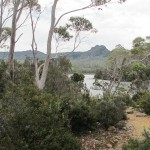
All for a view that hardly compared with that at Cradle Mountain, and with no respite from those flies either. We had decided to bypass the principal peak in the area, Mt. Rufus, since it seemed to pose a much more demanding climb than we preferred at the end of our active two weeks in Tasmania. Scaling Hugel made Rufus seem a much better choice.

Ultimately, though, our best viewing station was the front porch of our lakeside cabin in the park, not more than twenty feet from the wind-tossed shoreline and with a view of the distant hills over the waves. We spent hours in the evening just enjoying this soothing spectacle. The last of daylight was enlivened by the screech of cockatoos and kookaburras.
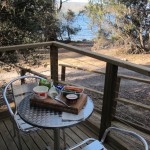
A spiky echidna waddled by in search of bugs. Then, brightening the evening, a full moon rose directly in front of us as if drawn straight up from the water on a cord. Soon quiet blanketed the night.
Perhaps the best known of the wilderness areas we visited is the Franklin-Gordon Wild Rivers National Park, mainly because of the historical effort to keep them that way. In the late 70s, the Tasmanian government was racing ahead to dam the Franklin River, which flows into the Gordon. A local protest to keep the river wild went, as we might say now, viral. Local and international environmental groups joined the protest. After years of stalling the action through legal means and physical blockades, the protestors forced the Tassie government to yield, a model triumph for subsequent efforts to prevent commercialization of great natural resources around the globe.
Paradoxically, however, one of the most commercial activities in the area is now tourism, because everyone wants to visit the famous rivers. Tourists certainly brought the sleepy town of Strahan back, with all the support resources like hotels and caravanning parks and restaurants.
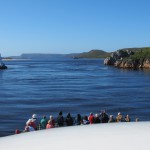
The action centers on the posh touring boats that ferry visitors around Macquarrie Harbor, a sheltered bay larger than Sydney Harbor, and then a short way up the winding Gordon River. In cabin cruiser comfort you head out to sea through the jaws of Hell’s Gate, the narrow and shallow passage for all ships arriving here, but the limiting factor in its use as a port since the entrance cannot be dredged or widened. Then you get a “gourmet” buffet lunch as you head for the Gordon.
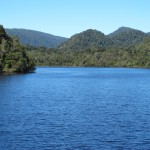
As the boat meanders upriver, the unspoiled forested hills unfurl past. You stop for a short while for a sign-posted nature walk, where you – and the two hundred others on board – follow a wooden walkway past venerable samples of the celebrated Huon Pine trees, the basis for logging in the 20th century.
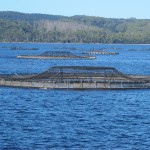
You return past steel fish-farming cages in the harbor, where companies like TasSal breed large quantities of Atlantic Salmon here in Pacific waters. Much is exported, but you can find plenty of inexpensive salmon (and our favorite smoked salmon) from here all over Tasmania and southeastern Australia, even on the ferry’s buffet.
Not exactly a wilderness experience, though perhaps as close as many people get. Still, for all their craving for comforts, you can see that these visitors want at least a taste of the wildness our ancestors knew intimately. Nearby upriver, a deeper immersion calls those who want more. In 7 to 10 days of canoeing, you can challenge the rapids of the rugged Franklin River and slip solemnly through its majestic gorges, camping on the banks just as aborigines did hundreds of years ago.
Most of us will always want our domesticated spaces, in our cities and towns. But the wilderness continues to call us from our backyards to return, however we dare, to something elemental in our nature.
(Also, for more pictures from Australia, CLICK HERE to view the slideshow at the end of the Australia itinerary page.)



